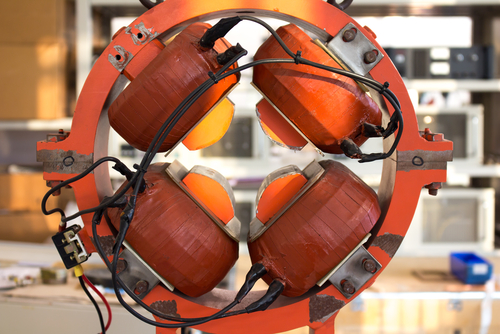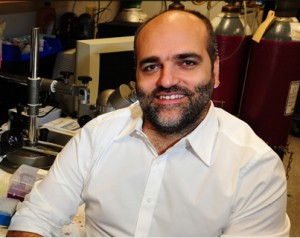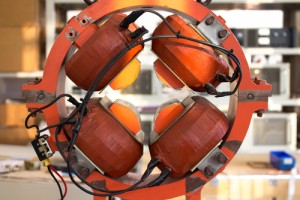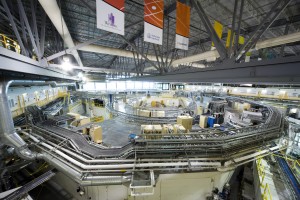Cool Synchrotron Device Advancing Cystic Fibrosis Research

Researchers at the University of Saskatchewan in Saskatoon, Canada working with the Canadian Light Source (CLS) synchrotron have developed a new imaging technique that reveals a heretofore unknown immune system component of the in the lungs — a discovery that could potentially benefit patients battling cystic fibrosis (CF) — an autosomal recessive genetic disorder caused by mutations in the gene encoding for the anion channel cystic fibrosis transmembrane conductance regulator (CFTR). The scientists’ findings are published in the Proceedings of the National Academy of Sciences (PNAS).
The paper, entitled “Pseudomonas aeruginosa triggers CFTR-mediated airway surface liquid secretion in swine trachea“ (PNAS Published online before print August 18, 2014, doi: 10.1073/pnas.1406414111), is coauthored by Xiaojie Luan, Veronica A. Campanucci, Manoj Nair, Orhan Yilmaz, and Juan P. Ianowski of the Department of Physiology, University of Saskatchewan; George Belev of Canadian Light Source Inc., Saskatoon, SK, Canada; Terry E. Machen of the Department of Molecular and Cell Biology at the University of California, Berkeley, CA; and Dean Chapman of the Department of Anatomy and Cell Biology, University of Saskatchewan; and edited by James M. Tiedje, Michigan State University, East Lansing, Michigan.
The researchers note that several organs are affected in CF, but most of the morbidity and mortality comes from lung disease caused by the failure to clear bacteria — a process that depends on a layer of airway surface liquid (ASL) consisting of both a mucus layer that traps, kills, and inactivates bacteria and a periciliary liquid layer that keeps the mucus at an optimum distance from the underlying epithelia, to maximize ciliary motility, and that removes bacteria from the airway through mucociliary clearance. They observe that recent data indicate that the initial consequence of CFTR mutation is failure to eradicate bacteria before the development of inflammation and airway remodeling. Bacterial clearance depends on a layer of airway surface liquid (ASL – part of the mucociliary system) consisting of both a mucus layer that traps, kills, and inactivates bacteria, dust and other particles, and a thinner periciliary liquid layer on which the mucus floats as it is swept out of the lungs by tiny hair-like cilia, keeping the mucus at an optimum distance from the underlying epithelia, to maximize ciliary motility and clearance of bacteria. The ASL also has bactericidal properties, not only trapping potential disease-causing microbes, but inactivating and killing them.
[adrotate group=”1″]
The coauthors say this study provides the first demonstration that inhalation of bacteria triggers CFTR-dependent ASL secretion. They suggest that this response to inhaled pathogens is an important but previously unknown element of the body’s innate immune response that is missing in CF patients, resulting in reduced bacterial killing and facilitating infection.  “We discovered that the airway responds to inhaled bacteria by secreting airway surface liquid,” says Dr. Juan Ianowski, assistant professor of physiology in the U of S College of Medicine and lead researcher on the team. “This is a previously unknown component of the innate immune defense.” The coauthors observe that the airways in CF patients and animal models of CF demonstrate abnormal ASL secretion and reduced antimicrobial properties. Thus, it has been proposed that abnormal ASL secretion in response to bacteria may facilitate development of the infection and inflammation that characterize CF airway disease. Whether inhalation of bacteria triggers ASL secretion, and the role of CFTR, have never been tested, however. The researchers developed a synchrotron-based imaging technique to visualize the ASL layer and measure the effect of bacteria on ASL secretion,and show that the introduction of Pseudomonas aeruginosa and other bacteria into the lumen of intact isolated swine tracheas triggers CFTR-dependent ASL secretion by the submucosal glands. This response requires expression of the bacterial protein flagellin. In patients with CF, the inhalation of bacteria would fail to trigger ASL secretion, leading to infection and inflammation. The discovery suggests that by helping this component function better for example, through early and sustained use of antibiotics it may be possible to improve lung function in cystic fibrosis patients. A Canadian Light Source release notes that over the last decade, scientists have hypothesized that in cystic fibrosis, a mutation to a gene called CFTR interferes with the production of ASL. The lungs of people with the mutation as well as test animals such as pigs, ferrets and mice all fail to respond to inhaled irritants and other threats that would prompt strong ASL production in healthy individuals. Also, the ASL that is produced has poor bactericidal properties. Until now, however, it has never been possible to answer two central questions: do bacteria trigger ASL secretion in the airways, and what is the role of CFTR in the process? The research team came up with a novel synchrotron-based method that unlocked the answer.
“We discovered that the airway responds to inhaled bacteria by secreting airway surface liquid,” says Dr. Juan Ianowski, assistant professor of physiology in the U of S College of Medicine and lead researcher on the team. “This is a previously unknown component of the innate immune defense.” The coauthors observe that the airways in CF patients and animal models of CF demonstrate abnormal ASL secretion and reduced antimicrobial properties. Thus, it has been proposed that abnormal ASL secretion in response to bacteria may facilitate development of the infection and inflammation that characterize CF airway disease. Whether inhalation of bacteria triggers ASL secretion, and the role of CFTR, have never been tested, however. The researchers developed a synchrotron-based imaging technique to visualize the ASL layer and measure the effect of bacteria on ASL secretion,and show that the introduction of Pseudomonas aeruginosa and other bacteria into the lumen of intact isolated swine tracheas triggers CFTR-dependent ASL secretion by the submucosal glands. This response requires expression of the bacterial protein flagellin. In patients with CF, the inhalation of bacteria would fail to trigger ASL secretion, leading to infection and inflammation. The discovery suggests that by helping this component function better for example, through early and sustained use of antibiotics it may be possible to improve lung function in cystic fibrosis patients. A Canadian Light Source release notes that over the last decade, scientists have hypothesized that in cystic fibrosis, a mutation to a gene called CFTR interferes with the production of ASL. The lungs of people with the mutation as well as test animals such as pigs, ferrets and mice all fail to respond to inhaled irritants and other threats that would prompt strong ASL production in healthy individuals. Also, the ASL that is produced has poor bactericidal properties. Until now, however, it has never been possible to answer two central questions: do bacteria trigger ASL secretion in the airways, and what is the role of CFTR in the process? The research team came up with a novel synchrotron-based method that unlocked the answer.
 “We developed a technique to measure airway fluid, which to our knowledge is the only way to do this,” says Dr. Dean Chapman, a professor of anatomy and cell biology and co-author on the PNAS paper. Dr. Chapman holds the Canada Research Chair in X-Ray Imaging. A specialist in the medical and biological applications of synchrotron light, Chapman also leads the Biomedical Imaging and Therapy beamline at the CLS, one of only a few such facilities in the world. Armed with the new technique, the researchers exposed swine tracheas to three of the most common bacteria that cause problems with cystic fibrosis patients. All prompted increased production of ASL, confirming its role as part of the immune systems response to inhaled bacteria a role that is compromised by the mutated CFTR gene.
“We developed a technique to measure airway fluid, which to our knowledge is the only way to do this,” says Dr. Dean Chapman, a professor of anatomy and cell biology and co-author on the PNAS paper. Dr. Chapman holds the Canada Research Chair in X-Ray Imaging. A specialist in the medical and biological applications of synchrotron light, Chapman also leads the Biomedical Imaging and Therapy beamline at the CLS, one of only a few such facilities in the world. Armed with the new technique, the researchers exposed swine tracheas to three of the most common bacteria that cause problems with cystic fibrosis patients. All prompted increased production of ASL, confirming its role as part of the immune systems response to inhaled bacteria a role that is compromised by the mutated CFTR gene.
The work, funded through a grant from Cystic Fibrosis Canada, supports a growing body of evidence that this inability to clear microbes from the lungs is at the root of airway disease in cystic fibrosis patients. Patients are afflicted with a persistent cough with thick mucus, wheezing and shortness of breath, and frequent lung infections. Eventually, the disease destroys lung tissue and contributes to illness and early death.
The Canadian Light Source is Canada’s national centre for synchrotron research and a global centre of excellence in synchrotron science and its applications. Located on the University of Saskatchewan campus in Saskatoon, the CLS has hosted over 2,000 researchers from academic institutions, government, and industry from Canada’s 10 provinces and 2 territories; delivered over 32,000 experimental shifts; received over 8,300 user visits; and provided a scientific service critical in over 1,000 scientific publications, since beginning operations in 2005. CLS operations are funded by Canada Foundation for Innovation, Natural Sciences and Engineering Research Council, Western Economic Diversification Canada, National Research Council of Canada, Canadian Institutes of Health Research, the Government of Saskatchewan and the University of Saskatchewan.
 Synchrotrons work by accelerating electrons in a tube to nearly the speed of light using powerful magnets and radio frequency waves. By manipulating the electrons, scientists can select different forms of very bright light using a spectrum of X-ray, infrared, and ultraviolet light to conduct experiments. Synchrotrons are used to probe the structure of matter and analyze a host of physical, chemical, geological and biological processes. Information obtained by scientists can be used to help design new drugs, examine the structure of surfaces in order to develop more effective motor oils, build more powerful computer chips, develop new materials for safer medical implants, and help clean up mining wastes, to name a few applications.
Synchrotrons work by accelerating electrons in a tube to nearly the speed of light using powerful magnets and radio frequency waves. By manipulating the electrons, scientists can select different forms of very bright light using a spectrum of X-ray, infrared, and ultraviolet light to conduct experiments. Synchrotrons are used to probe the structure of matter and analyze a host of physical, chemical, geological and biological processes. Information obtained by scientists can be used to help design new drugs, examine the structure of surfaces in order to develop more effective motor oils, build more powerful computer chips, develop new materials for safer medical implants, and help clean up mining wastes, to name a few applications.
For more information visit the CLS website: https://www.lightsource.ca/
Supporting information for the PNAS article can be found online at:https://www.pnas.org/lookup/suppl/doi:10.1073/pnas.1406414111/-/DCSupplemental
Sources:
The Canadian Light Source
Proceedings of the National Academy of Sciences (PNAS)
University of Saskatchewan
Image Credits:
The Canadian Light Source
University of Saskatchewan








